George Andrew Sim (1929 – 2012)
 George
Sim was a pioneer of modern chemical crystallography and the deviser of the
Sim-weighted electron density synthesis, familiar to SHELX users as FMAP 5.
George
Sim was a pioneer of modern chemical crystallography and the deviser of the
Sim-weighted electron density synthesis, familiar to SHELX users as FMAP 5.
He was born in Aberdeen and began his long association with the Chemistry Department of the University of Glasgow in 1948. After taking an expected First, he joined J.M. Robertson's X-ray diffraction group in 1952 and soon convinced his supervisor that he was “a research worker of outstanding brilliance and originality.” He then moved to Cochran's group at the Cavendish Laboratory to work on theoretical aspects of the heavy atom method, and did his national service with the Atomic Weapons Establishment at Aldermaston before returning to Glasgow as ICI research fellow. He was appointed as lecturer in 1957 and after a few years at the University of Illinois came to Sussex 1966. He left in 1970 to succeed Robertson in the Gardiner Chair of Chemistry.
During his years at Sussex he published about 80 papers in international journals. He received a substantial grant from the EPSRC to set up the Sussex crystallography service, which went on, under the direction of Peter Hitchcock, to elucidate many hundreds of structures of small molecules. His collaborators included M.A. Bush, G.M. McLaughlen, M.G. Waite and D.N.J. White. He was awarded the Corday-Morgan Medal and Prize of the Royal Society of Chemistry for 1963 and, in 1967, the Fritzche Prize of the American Chemical Society that recognises outstanding achievements in the analysis, structure elucidation and chemical synthesis of natural products [Other Sussex recipients were J W Cornforth (1969) and Ian Scott (1976)]. His work on the alkaloidal tumour inhibitor camptothecin was noted by the ACS as a ‘landmark in Chemical History’.
Crystallographers always have long publication lists because they receive crystals as gifts from other research groups; their vital evidence often confirms what has already be deduced by much less certain procedures. George collaborated with colleagues at the Universities of Illinois, Glasgow and Basle to produce long series of papers on sesquiterpenoid tumour inhibitors and other natural products, and with George Knox and others at Strathclyde to write a series on metal carbonyl and nitrosyl complexes. At Sussex he began collaborations with Joseph Chatt and Ray Richards on carbene complexes of platinum, with Jim Hanson on natural products, and with David Smith on the structures of amido- and imidoaluminium derivatives. With the computer power universally available today, crystal structures of small molecules can be routinely solved in an hour or two, so researchers sometimes now turn to crystallography as a first rather than as a final technique for the characterisation of a new compound. In the late 1960s the situation was very different; data were collected photographically on packs of Weissenberg photographs. The shades of grey in the photographs were analysed patiently by comparison with spots of known relative intensity. Computers were slow and the programs that ran on them were primitive by modern standards. DEUCE which was used for most of Sim's work at this time took 8–12 hours for a three-dimensional Fourier calculation and the scale factor had to be punched onto a Hollerith card in Chinese binary. The calculated electron density values were written by hand onto a correctly scaled grid, contour lines drawn and the contours transferred to glass sheets. George's ability to filter the correct structure from the noise in a poorly phased map was legendary. Once, when the computer had broken down in the middle of the calculation, he solved a structure with only half the map available.
It was particularly difficult to solve the structures of organic molecules that contained no heavy element. In one case at Sussex [(MeAlNMe)7] George had to put aside a data set on which he was making little progress until the so-called ‘direct methods’ which he was developing as a crystallographer made a solution possible a year or two later.
As well as working on his research, George taught the basic course in thermodynamics to all the undergraduates in the School of Molecular Science.
George remained at Glasgow till he retired in 1990. He actively pursued a variety of structural themes: natural product chemistry, conformational studies of nine-, ten- and eleven-membered rings, the stereochemistry of mercury complexes and of metal-carbonyl and -nitrosyl complexes. He also put much effort into the six volumes of the Chemical Society Specialist Periodical Reports on Molecular Structure by Diffraction Methods, which he co-edited with L.E. Sutton, and his co-editorship of Acta Crystallographica. He was a founder member and active supporter of the British Crystallographic Association and he became a Fellow of the Royal Society of Edinburgh.
He never lost his love for experimental crystallography. He was not the kind of professor who worked exclusively through the hands of others. Throughout his career he was frequently to be found in the X-ray laboratory, abstractedly humming some favourite classical theme as he worked on a crystal. Shortly before he retired he began to follow order-disorder transitions by studying the effect of changing temperature on crystal structure. Typically, in a paper on nitrogen inversion in a 1,3,5-triazacycohexane from structure analyses at 127, 250, 268 and 293 K, he did all the experimental and computational work himself.
One of us (KM) worked as a crystallographer in his department for many years. George was as one would wish a senior colleague to be; he took the trouble to read one’s work, he was always supportive and offered valid comment discreetly. He was equally critical of his own work which he always assessed very soberly.
Two years before his death George suffered a stroke from which he did not fully recover. He is survived by his wife Margaret and by his children Kenneth and Linda.
Ken Muir and David Smith
A longer obituary by KM has been published in Crystallography Today 124(2013).